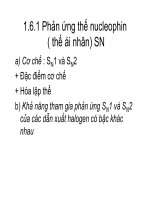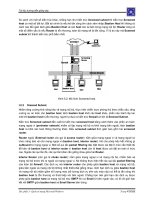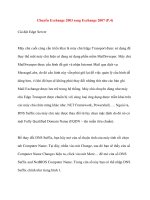4 magnesium halogen exchange
Bạn đang xem bản rút gọn của tài liệu. Xem và tải ngay bản đầy đủ của tài liệu tại đây (669.41 KB, 5 trang )
Chem 115
Magnesium-Halogen Exchange
Myers
Review:
Knochel, P.; Dohle, W.; Gommermann, N.; Kneisel, F. F.; Kopp, F.; Korn, T.; Sapountzis, I.;
Ahn Vu, V. Angew. Chem., Int. Ed. Engl. 2003, 42, 4302.
General References on the Preparation and Reactions of Grignard Reagents:
Main Group Metals in Organic Synthesis, Yamamoto, H., Oshima, K., Eds.; John Wiley and
Sons: New York, 2004.
Handbook of Grignard Reagents, Silverman, G. S., Rakita, P. E., Eds.; Marcel Dekker:
New York, 1996.
Organomagnesium Methods in Organic Synthesis, Wakefield, B. J.; Academic Press:
San Diego, 1995.
• Unlike many lithium-halogen exchange protocols, only one equivalent of i-PrMgX is used
in typical experimental procedures.
• THF is the most common solvent. Ethyl ether has been employed as a solvent for
selective exchange of geminal dihalides to generate magnesium carbenoids.
• The reactivity of Grignard reagents is highly temperature dependant. Only highly reactive
electrophiles such as aldehydes and ketones react at significant rates below 0 °C. This
allows for the preparation of organomagnesium reagents containing cyano, nitro, ester,
and imine functional groups, provided that the rate of the exchange reaction is fast enough
to allow for exchange at temperatures below 0 °C.
• The rate of magnesium-halogen exchange is accelerated by electron-withdrawing groups
on the aromatic ring, and is slowed by electron-donating groups:
Development and General Aspects:
I
RX + R'MgX'
RMgX' +
MgBr
R'X
i-PrMgBr
THF, –20 °C, 30 min
• Analogous to lithium-halogen exchange. The position of the equilibrium varies with the
stabilities of the carbanion intermediates involved (sp >> sp2 >> sp3).
Br
+
EtMgBr
Et2O
20 °C, 12 h
MgBr +
EtBr
CO2CH3
CO2CH3
Jensen, A. E.; Dohle, W.; Sapountzis, I.; Lindsay, D. M.; Ahn Vu, V.; Knochel, P.
Synthesis 2002, 565.
I
MgBr
i-PrMgBr
Prévost, C. Bull. Soc. Chim. Fr. 1931, 49, 1372.
THF, 25 °C, 1 h
• Although the first example was reported in 1931 (above), the preparation of Grignard
reagents via metal-halogen exchange has not been widely used until recently. Knochel and
coworkers have demonstrated the functional-group tolerance of magnesium-halogen
exchange, which is now the method of choice for the preparation of highly functionalized
organomagnesium reagents.
• i-PrMgCl or i-PrMgBr are the most common reagents. In most cases, these reagents can be
used interchangeably. i-PrMgBr is made by the Grignard reaction of isopropyl bromide
and magnesium turnings. It is less soluble than the chloride (solutions are ~0.8 M), and the
titre must be checked more often. i-PrMgCl is commercially available as a 2.0 M solution
in THF or diethyl ether.
• Solutions of i-PrMgX are titrated by the method of Paquette (Lin, H.-S.; Paquette, L. A. Synth.
Commun. 1994, 24, 2503.) According to this procedure, a flame-dried flask is charged with
menthol (a non-hygroscopic solid), 1,10-phenanthroline (indicator) and THF. The Grignard
reagent is then added until a distinct violet or burgundy color persists.
OCH3
OCH3
Cali, P.; Begtrup, M. Synthesis 2002, 63.
I
MgCl
NO2
NO2
PhMgCl
THF, –40 °C, 30 s
NO2
NO2
Sapountzis, I.; Knochel, P. Angew. Chem., Int. Ed. Engl. 2002, 41, 1610.
Jason Brubaker
1
• Aryl bromides undergo exchange more slowly than iodides, but electron-poor aryl bromides
can still react at temperatures below 0 °ˇC.
I
• Dibromides undergo regioselective exchange of the bromine ortho- to a chelating group.
Note also the compatibility of the amidine group with the exchange reaction.
MgBr
N(CH3)2
i-PrMgBr
N
–40 °C, 30 min
Br
Br
Br
F
F
i-PrMgBr
–78 °C, 30 min
F
F
F
F
THF, –10 °C, 1.5 h
Br
Br
OCH3
Br
MgBr
F
Bu
Br
Br
Br
MgBr
CO2
OCH3
CO2H
THF, 40 °C, 5 h
F
F
Br
Br
90%
Nishiyama, H.; Isaka, K.; Itoh, K.; Ohno, K.; Nagase, H.; Matsumoto, K.; Yoshiwara, H.
J. Org. Chem. 1992, 57, 407.
F
i-PrMgBr
23 °C, 2 h
F
OH
NC
Br
OCH3
MgBr
i-PrMgCl
F
i-PrMgBr
F
F
N
Bu
68%
F
–10 °C, 1 h
MgBr
• Higher temperatures are required for the selective exchange with less effective chelators.
F
F
NC
i-PrMgBr
Varchi, G.; Jensen, a. E.; Dohle, W.; Ricci, A.; Cahiez, G.; Knochel, P. Synlett 2001, 477.
MgBr
F
Br
N(CH3)2
CHO
N
NC
Bomond, L.; Rottlander, M.; Cahiez, G.; Knochel, P. Angew. Chem., Int. Ed. Engl. 1998, 37,
1701.
F
N(CH3)2
Functional Groups Compatible with the Magnesium-Halogen Exchange:
F
• Ester, benzylic chloride:
Abarbri, M.; Dehmel, F.; Knochel, P. Tetrahedron Lett. 1999, 40, 7449.
CO2CH3
CO2CH3
i-PrMgBr
Cl
Ortho- Directing Groups:
I
• The presence of a chelating ortho- group facilitates exchange, increases the rate of
reaction, and allows for low-temperature exchange.
Br
BrMg
OCH2OEt
NC
Et
O
NC
Cl
MgBr
NPh
–10 °C → 23 °C
O
75%
Delacroix, T.; Berillon, L.; Cahiez, G.; Knochel, P. J. Org. Chem. 2000, 65, 8108.
• Secondary alkyl tosylate:
O
i-PrMgBr
THF, –30 °C, 2 h
THF, –30 °C, 1 h
CO2CH3
PhN C O
Br
CuCN 2LiCl
OTs
OCH2OEt
NC
80%
Knochel, P.; Dohle, W.; Gommermann, N.; Kneisel, F. F.; Kopp, F.; Korn, T.; Sapountzis, I.;
Ahn Vu, V. Angew . Chem., Int. Ed. Engl. 2003, 42, 4302.
O
EtO2C
I
CH3
i-PrMgCl
THF, –20 °C, 1 h
O
CuCN·2LiCl
–20 → 25 °C
EtO2C
83%
CH3
Kneisel, F. F.; Monguchi, Y.; Knapp, K. M.; Zipse, H.; Knochel, P. Tetrahedron 2002, 43,
4875.
Jason Brubaker
2
• Unprotected anilines:
• Nitrile:
OH
NC
I
NC
i-PrMgBr
MgBr PhCHO
NC
NH2
Ph
I
THF, –40 °C, 30 min
89%
I 1. PhMgCl
–30 °C, 5 min
I
CHO
NHMgCl
MgCl
NH2 OH
I
Bu
Bu
2. i-PrMgCl
–25 °C, 10 min
CN
CN
CN
71%
• Tertiary amide:
Varchi, G.; Kofink, C.; Lindsay, D. M.; Ricci, A.; Seconi, G.; Knochel, P. Chem. Commun. 2003, 396.
O
Br
i-PrMgBr
N
I
O
• In the above example, phenyl magnesium chloride is first added because it is a strong
base and as a magnesium-halogen exchange reagent it is less reactive than i-PrMgX.
This allows for quantitative deprotonation before exchange.
N
THF, –25 °C, 30 min
81%
• Heteroaromatics:
Bomond, L.; Rottlander, M.; Cahiez, G.; Knochel, P. Angew. Chem., Int. Ed. Engl. 1998, 37,
1701.
Conditionsa
(°C, h)
Heterocycle
• Amidine, note also the selective exchange of a diiodide:
i-PrMgBr
I
I
MgBr
–20 °C, 5 min
1. CuCN·2LiCl
2.
CO2Et
CO2Et
F
N(CH3)2
N
N
I
I
Product
Yield (%)
Br
N(CH3)2
N(CH3)2
Electrophile
F
F
N
I
CO2Et
Br
(CuCN added)
F
Br
25, 1.5
N
80
F
S
OH
N
Ph
75
PhCHO
N
CO2Et
F
F
S
CH3
O
F
N
O
CH3
–40, 0.5
87%
Br
N
Br
Br
Varchi, G.; Jensen, A. E.; Dohle, W.; Ricci, A.; Cahiez, G.; Knochel, P. Synlett 2001, 477.
N
OEt
–20, 1
N
NC
• Imine:
N
OEt
59
OEt
CH3
I
CO2Et
O
CH3
MgBr
N
iPr
i-PrMgBr
1. BiCl3
THF, 25 °C
2. SiO2
N
iPr
O
Br
Bi
H
3
N
Bn
Br
O
CO2Et
–5, 1
PhCHO
Br
OH
N
Bn
73
Ph
34%
Murafuji, T.; Nishio, K.; Nagasue, M.; Tanabe, A.; Aono, M.; Sugihara, Y. Synthesis 2000, 1208.
• Imines can be used to mask aryl aldehydes during the magnesium halogen exchange. The
low yield of the reaction sequence above is likely attributable to the second step of the
procedure.
Br
a
–30, 1
Br
(CuCN added)
O
CO2Et
80
i-PrMgBr (1.2 equiv), THF
Abarbi, M.; Dehmel, F.; Knochel, P. Tetrahedron Lett. 1999, 40, 7449.
Jason Brubaker
3
• Nitro arenes:
NO2
NO2
I
FG
MgCl
PhMgCl
E
E+
FG
–40 °C, 5 min
FG
Electrophile
Nitro arene
NO2
Yield (%)
Product
NO2
NO2 OH
• The nitro group must be ortho to the iodide exchanged. Meta- and para-nitro substituted
aryl iodides give complex mixtures.
• PhMgCl is necessary for a successful reaction. More reactive Grignard reagents such as
i-PrMgCl give complex mixtures.
I
Ph
PhCHO
• Nitro-substituted organometallic reagents are difficult to prepare through classical
methods. These electron-deficient arenes tend to undergo electron-transfer reactions,
and direct oxidative addition with elemental magnesium or zinc often leads to reduction of
the nitro group. This new procedure is the best method to date for the preparation of
nitroarene organometallics.
87
• For successful reactions with reactive electrophiles such as allyl bromides and acid halides,
transmetallation of the organomagnesium intermediate with CuCN·2LiCl is necessary.
NO2
NO2 OH
I
Ph
PhCHO
94
• Pd-catalyzed Negishi cross-coupling reactions are possible after transmetallation with
ZnBr2:
O
NO2
CN
CN
NO2
NO2 OH
I
NC
I
Ph
PhCHO
CH3O
72
CH3O
NO2
1. mesitylMgBr, –40 °C, 5 min
2. ZnBr2, –40 °C, 5 min
3. Pd(dba)2 (5 mol %)
1 (10 mol %), 2 (1.5 equiv) NC
–40 → 23 °C, 3 h
NO2
CO2Et
1=
P
3
CO2Et
2=
73%
I
• In the case above, mesityl magnesium bromide is used to prevent competing oxidative
addition of the aryl iodide generated in the magnesium-iodide exchange reaction.
NO2 OH
I
cHex
cHexCHO
EtO2C
64
Magnesium-Halogen Exchange of Vinyl Iodides:
EtO2C
NO2
1. i-PrMgBr, THF
25 °C, 18 h
NO2 O
I
I
Ph
PhCOBr
EtO2C
76
I
Ph
PhCHO
O2N
O2N
2. PhCHO
Ph
CH3O
Ph
OH
Rottlander, M.; Boymond, L.; Cahiez, G.; Knochel, P. J. Org. Chem. 1999, 64, 1080.
CO2Et
Br
I
1. i-PrMgBr, THF
–70 °C, 12 h
95%
NO2
I
I
81
O2N
NO2
Ph
CH3O
NO2 OH
OH
60%
EtO2C
NO2
Ph
2. PhCHO
CO2Et
Sapountzis, Ioannis; Knochel, P. Angew. Chem., Int. Ed. Engl. 2002, 41, 1610.
74
• Vinyl Iodides are also suitable substrates for magnesium-halogen exchange. Higher
temperatures and longer reaction times are required, which limits the functionalgroup tolerance of this method.
• When the vinyl iodide is substituted with electron-withdrawing groups or chelating
heteratoms, the rate of exchange is enhanced.
Jason Brubaker
4
Alternative, More Reactive Reagent Combinations for Magnesium-Halogen Exchange:
• Enhanced Reactivity by Addition of Lithium Chloride to i-PrMgCl prior to exchange (1 equiv):
• Lithium Trialkyl Magnesium Ate Complexes:
OH
Br
OH
1. Bu3MgLi (1.2 equiv)
THF, –78 °C, 0.5 h
I
2. C6H13CHO
CH3O
1. i-PrMgCl·LiCl
THF, 0 °C, 2 h
2. PhCHO
NC
Ph
NC
81%
C6H13
Krasovskiy, A.; Knochel, P. Angew. Chem., Int. Ed. Engl. 2004, 43, 3333.
CH3O
94%
Br
1. Bu3MgLi (1.2 equiv)
THF, 0 °C, 0.5 h
2.
CH3O
Br
1. i-PrMgCl·LiCl
THF, –40 °C, 7 h
C6H13
I
1. i-PrBu2MgLi (1.2 equiv)
THF, –78 °C, 1 h
2.
O
C10H21
Br
I
2. TMSCl
I
2. EtCHO
I
OH
Et
84%
t-BuO
O
CuCN·2LiCl
1. i-PrBu2MgLi (1.2 equiv)
THF, 0 °C, 1 h
H
1. i-PrMgCl·LiCl
THF, –40 °C, 7 h
I
t-BuO
O
71%
CH3O
84%
Br
C6H13
2. DMF
66%
Ren, H.; Krasovskiy, A.; Knochel, P. Org. Lett. 2004, 6, 4215.
• Addition of LiCl to the Grignard reagent produces a more active magnesium-halogen
exchange reagent
C10H21
TMS
93%
Inoue, A.; Kitagawa, K.; Shinokubo, H.; Oshima, K. J. Org. Chem. 2001, 66, 4333.
• The lithium trialkyl magnesiates are prepared in situ by the addition of an alkyl lithium
(2 equiv) to an alkyl magnesium halide (1 equiv).
• Magnesiates exhibit a reactivity somewhere between alkyllithium and alkylmagnesium
reagents.
• The exchange reaction is faster and less sensitive to electronic effects (arene substitution).
• In accord with their greater reactivity, aryl magnesiates show less funtional group tolerance.
• It has been proposed that LiCl breaks up aggregates of organomagnesium reagents.
• This more active reagent combination is successful in the exchange of the ortho-phenoxy
aryl iodide shown below:
CO2Et
I
OH
1. CH3MgCl, LiCl
THF, –30 °C, 0.5 h
2. i-PrMgCl
–30 °C, 0.5 h
CO2Et
Ph
3. PhCHO
OH OH
62%
Kopp, F.; Krasovskiy, A.; Knochel, P. Chem. Commun. 2004, 2288.
Jason Brubaker
5









